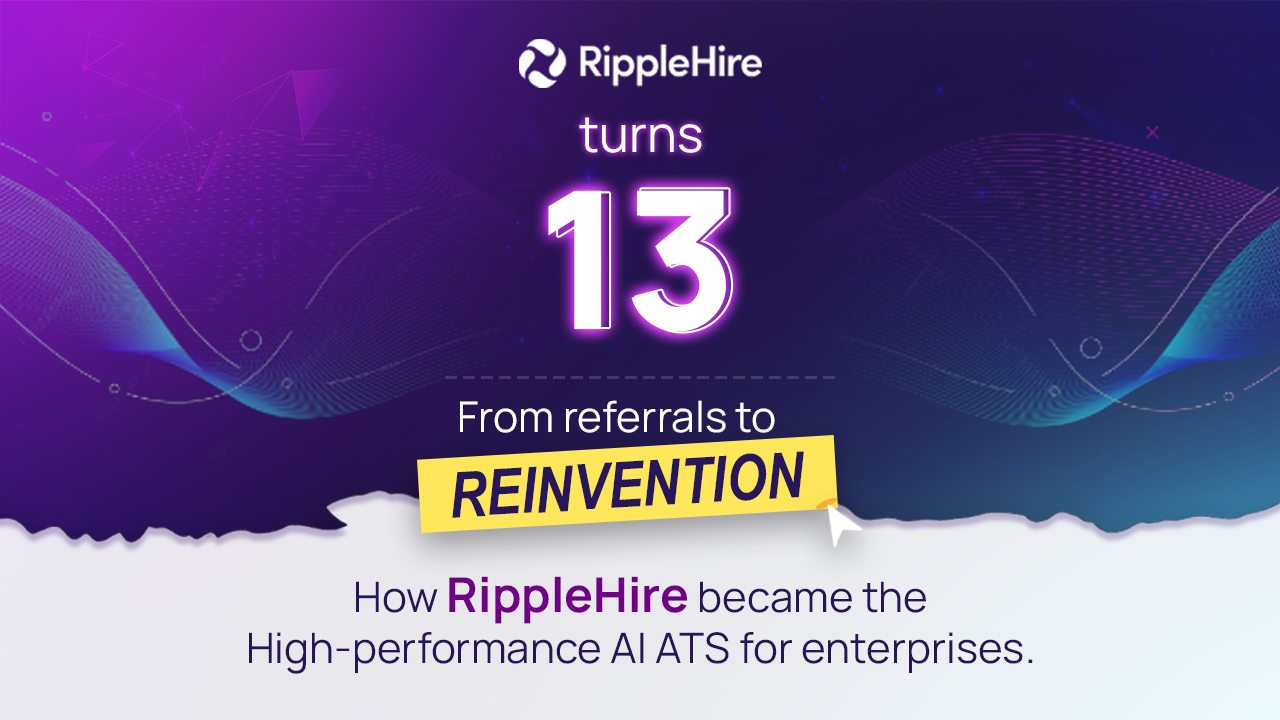Managing Large Applicant Volume Without Losing Control
Hiring at scale isn’t just about numbers. It’s hard because humans and systems get stretched past what they were built for. Feedback gets lost, and small delays multiply. The result is noise instead of progress.
The smartest hiring teams aren’t reacting faster; they’re designing calmer systems with simple checkpoints, clear ownership, and just enough automation to keep things moving without losing the human touch.
This article looks at how to handle thousands of applications without losing track, patience, or good candidates.
5 ways to manage large applicant volumes without losing control
The best hiring teams don’t try to manage chaos; they prevent it. Here’s how.
1. Set up filters before the flood
They fail because teams start screening after the applications land, not before. By the time recruiters open the first batch, the pile has already doubled, and what could have been a system turns into triage.
The simplest way to stay ahead is to decide what matters most before the applications arrive. List the non-negotiables: education level, years of experience, work eligibility, required skills, or location preferences. Then build filters around those. When your system automatically screens for these basics, recruiters spend their time on judgment, not data cleanup.
If your process allows pre-registration, use it wisely.
Ask short, purposeful questions that sort candidates early: “Are you open to relocation?” “Have you completed the XYZ certification?” “When can you join?” These filters may sound small, but they prevent hours of wasted coordination later.
A good ATS or hiring platform, like RippleHire, can take this further by tagging and auto-sorting profiles as they come in. Instead of scanning 2,000 resumes, your recruiters see 200 that match the baseline.
2. Build a simple scoring system to make decisions faster
When applications pile up, manual sorting becomes a black hole. Recruiters scan dozens of resumes, make quick mental notes, and move on — but nothing stays consistent. One person’s “good fit” is another’s “maybe.” That’s how qualified candidates slip away unnoticed.
A scoring model turns that chaos into clarity. Instead of guessing who to move forward, you assign value to what truly matters for the role. It’s not about making hiring robotic; it’s about making it fair, fast, and repeatable.
Start by breaking the role into measurable parts. For example:
- Must-haves: eligibility, education, core skills, and location preference.
- Performance indicators: communication, attitude, and domain understanding.
- Role readiness: notice period, willingness to relocate, stability in past roles.
Assign each category a weight. Say, 40% for core skills, 30% for performance, 20% for readiness, 10% for extras. This doesn’t need to be perfect; it just needs to be consistent.
Once you apply this structure, every recruiter works from the same playbook. Two candidates might have different experiences, but they’ll be compared on the same factors. It removes bias and saves time spent debating “gut feel.”
You can take this further by combining the model with digital assessments. When test results feed into your scoring automatically, you don’t have to cross-check spreadsheets or wait for interview notes.
The outcome isn’t just faster shortlisting. It’s a better collaboration.
Recruiters, hiring managers, and interviewers speak the same language because the data is clean and comparable. And when thousands of applications come in at once, that shared system becomes the difference between feeling buried and staying in control.
3. Keep everything on track so nothing slips through
When hiring drives go off track, it’s rarely because of bad candidates — it’s because everyone’s looking at different data. One team is using an Excel sheet, another has notes in an email, and the feedback from yesterday’s interviews is sitting in someone’s downloads folder. Multiply that by a few thousand applicants, and you have instant confusion.
The fix isn’t fancy tech. It’s visibility.
Bring every stage of your hiring drive into one connected track — a single view that shows where each candidate stands and what’s next. It can look something like this:
|
What |
Where It Lives |
Why It Matters |
|
Candidate details |
Centralized profile |
Avoids duplicate entries or missing resumes |
|
Assessment results |
Auto-linked to profile |
Keeps recruiters from switching between tools |
|
Interview feedback |
Captured in real time |
Builds transparency and accountability |
|
Communication logs |
Stored within the system |
Ensures no candidate is left hanging |
When your system shows the whole story, your team stops chasing updates. Everyone (recruiters, interviewers, hiring managers) sees the same truth at the same time.
It’s also a cultural shift. No side spreadsheets, no “I’ll email it later.” Make it a habit that if it’s not in the system, it didn’t happen. That small rule keeps large-scale hiring predictable, even when the numbers climb.
4. Automate follow-ups, not conversations
Every recruiter knows the feeling when you’ve just wrapped up a drive, and your inbox explodes. Candidates want updates, interviewers haven’t shared feedback, and hiring managers are asking for status reports. The volume doesn’t overwhelm because people are careless; it overwhelms because follow-ups never stop.
That’s where automation earns its keep. It doesn’t replace human connection; it protects it. When routine tasks run automatically, recruiters get their time back to focus on the parts that truly need judgment or empathy.
Here’s what to automate first:
- Reminders and scheduling: Automatically nudge interviewers when feedback is pending, or candidates when their slot is confirmed. No manual chasing.
- Status updates: A simple “Your application is under review” or “You’ve been shortlisted for the next round” can be sent instantly from your system. It keeps candidates informed without waiting for a recruiter’s free minute.
- Data sync: Let your system pull in test results or attendance data from assessment tools instead of someone exporting and uploading files.
But here’s the line you shouldn’t cross — automate process, not presence. Candidates can spot the difference between a thoughtful message and a cold template. Keep empathy in your tone, even if the message is triggered automatically.
When automation takes care of the noise, recruiters can finally spend time on what software can’t do, such as genuine conversations, faster decisions, and building trust in the middle of high-volume hiring.
5. Measure what slows you down
You can’t fix what you don’t track. Most large drives feel chaotic, not because teams lack effort, but because they don’t know where the slowdown is happening.
Tracking isn’t just about counting hires or offers. It’s about seeing where your process loses momentum. Maybe candidates are waiting too long between rounds. Maybe interview feedback takes three days. Maybe offers sit idle in approval.
Start simple by measuring time, touchpoints, and drop-offs.
Watch these key signals:
- Response time: How quickly do recruiters and interviewers act after each stage?
- Candidate wait time: How long does it take from application to first contact?
- Conversion rates: From test to interview, from interview to offer, from offer to join.
- Feedback lag: Average time taken to submit evaluations.
Then ask one question for each number: Is this delay avoidable or necessary?
Once you identify the choke points, fix them with clarity, not pressure. A quick template for interview feedback can save more time than adding another recruiter. Auto-notifications can stop hundreds of “any update?” emails.
Measurement isn’t about micromanaging people. It’s about giving your team visibility and breathing space. When everyone knows where time leaks, the whole process starts moving with intent instead of urgency.
Bring order to volume hiring with RippleHir.e
Handling thousands of applications shouldn’t feel like crisis management. The best hiring teams don’t chase candidates or updates; they create systems that run smoothly even when the numbers explode. That’s what RippleHire helps you build.
RippleHire’s AI-powered ATS brings every part of high-volume hiring into one connected track. Screening filters, candidate scoring, scheduling, and interviewer feedback all flow through a single system — giving recruiters complete visibility and control. No more scattered spreadsheets or missed follow-ups.
You can:
- Automatically filter and score applicants as they apply.
- Track interviews, communication, and feedback in real time.
- Identify bottlenecks instantly with built-in analytics.
- Deliver timely updates and a consistent candidate experience at scale.
The result is a calmer, faster hiring engine where recruiters focus on people, not paperwork. And candidates actually enjoy the process.
Managing large applicant volumes doesn’t have to mean working harder. It’s about designing smarter systems that scale without losing control. Book a demo with RippleHire to see how you can bring clarity, speed, and calm to every hiring drive.
Frequently Asked Questions
How do you manage a high volume of job applications effectively?
Start by setting filters before applications come in. Define must-haves like skills, location, or eligibility, and let your hiring platform automatically screen out mismatches. This saves recruiters from manually reviewing every resume and ensures focus stays on the most relevant candidates.
What is the best way to shortlist candidates at scale?
Use a simple scoring system. Assign weights to key factors like skills, communication, and role readiness. This makes evaluations consistent and faster. When combined with digital assessments or an ATS, scores update automatically — giving recruiters an objective shortlist without endless debates.
How can technology help manage thousands of applicants?
An Applicant Tracking System (ATS) keeps all candidate data, feedback, and communication in one place. It can filter resumes, schedule interviews, send updates automatically, and show recruiters where every candidate stands. Tools like RippleHire simplify this process, keeping large-scale hiring organized and transparent.
What parts of hiring should be automated and what should stay human?
Automate repetitive tasks like reminders, scheduling, and status updates — not personal interactions. Candidates still value empathy and timely communication. Let automation handle the routine follow-ups so recruiters can spend their energy on meaningful conversations and faster decisions.
How can teams avoid chaos during large hiring drives?
Keep visibility high and measure what slows you down. Track how long candidates wait between rounds, how fast feedback is submitted, and where drop-offs happen. Small fixes like standard templates or instant notifications can prevent pileups. With clear ownership and real-time tracking, large drives feel calm and under control.















